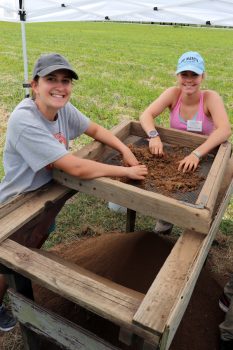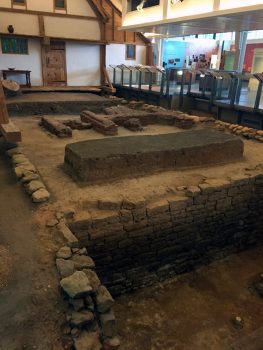Back to Dispatches from Field School
Field School 2019 – Week 2
McKenna Litynski — St. Mary’s College of Maryland
“On the Road to Artifact Discoveries”
Our group began the week learning about 19th-century ceramics that have changed over the years from vibrant and colorful glazes to intricate designs decaled onto plates. We spent our afternoon learning about tobacco pipes and glass. It is very important to understand the different ways various types of pipes are made as tobacco was one of the most important items for the development of Maryland. My favorite tobacco pipe is the terracotta pipe, made by the Native Americans out of brown clay and decorated by pressing fossilized shark teeth onto the exterior of the pipe.
Tuesday morning, we set up tents and brought equipment out of the archaeology trailer. My field partner and I finished screening the topsoil and grass and came across many small pieces of red brick. We found pieces of Buckley ceramics, an earthenware made from red and yellow clay and a lead glaze that is black in color. Wrought nails and European tobacco pipe stems and bowls were also uncovered by many field students. My favorite find of the morning was a prehistoric preform made of quartz. Just before lunch, we found a white ironstone ceramic and Rhenish brown stoneware. Creating straight side walls in all units was a necessity. In the afternoon, field students found manganese-mottled earthenware and Staffordshire ceramics. In addition, my partner and I came across a rather large brick lodged in the side wall of our unit. We are going to have to work around it for now!
Wednesday was a rainy day, but it certainly was not gloomy. We began our day by learning about many different types of soil. Soil is important in archaeology as it can help us better understand the artifacts found within a certain color, texture, and strata of soil. I enjoyed feeling the difference between velvety clay and gritty sandy loam. We had the privilege of receiving a lecture from Senior Staff Archaeologist Ruth Mitchell on the mitigation strategies and archaeology of the Mill Field and Anne Arundel Hall. Later that day, we learned about prehistoric artifacts and architectural features. It was breathtaking to touch and see projectile points used over 10,000 years ago! The architectural features were equally interesting, and I paid close attention to the differences between wrought nails, cut nails, and wire nails.
On Thursday, the high temperature (90 degrees) and humidity did not keep any field students from finding incredible artifacts including pipe stems, many different ceramics, and flakes to prehistoric tools. By mid-morning, I found a beautiful secondary flake from a prehistoric artifact. After an enjoyable lunch in air conditioning, my partner and I headed back out to the field to find English porcelain. It was a challenge to claim screens during this time as everyone was very enthusiastic about their work! Thunder rolled in the distance, but thankfully the storms were not moving in our direction. I felt the thunder added a dramatic effect to our artifact excavations. At the end of the day, tin glazed earthenware, shards of glass, and more European tobacco pipe stems were found by many students.
On Friday morning, I found Rhenish blue and grey stoneware with incision decorations. The field students working in the unit closest to mine found a fragment European pipe bowl with rouletting, and an animal bone was uncovered in the unit farthest from mine. Due to thunderstorms, we headed over to the St. John’s Site Museum and enjoyed a tour led by Dr. Henry Miller. The site is the ruins of a house built in 1638 by John Lewger and stood until 1715. In 1654, the house was occupied by Simon Overzee who did major renovations to the home. Overzee owned many slaves, including a defiant slave, named Antonio, who was one of the only slaves who died refusing to work. Later, the St. Johns house was made into an inn/tavern. Another interesting fact about the St. Johns site is that Margaret Brent requested the right to vote in 1648 in this very house. It was incredible to see the many artifacts found during excavation of this site including rosary beads, floor tile, iron keys, various types of ceramics and glass, etc.
If I had to pick one word to summarize the week, it would be “amazing”! We had the opportunity to see, touch, and study amazing artifacts in the study collection room, had a fun and amazing time working in the field, and saw the breathtaking and amazing site of St. Johns. I am so excited to be a part of this field school and can’t wait to see what next week has in store for us!




